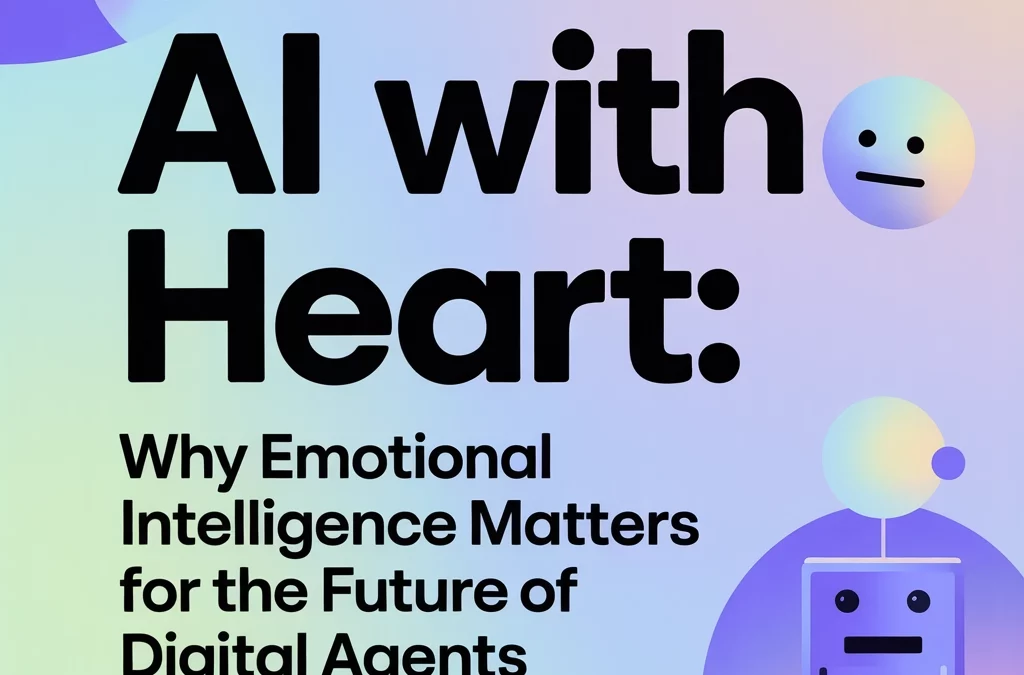The Rise of Emotionally Intelligent AI
Remember when talking to a digital assistant felt like conversing with a particularly dense robot? Those days are rapidly fading into memory. As we move through 2025, the most significant evolution in artificial intelligence isn't just happening in raw processing power or knowledge breadth—it's occurring in the realm of emotional intelligence.
Today's leading AI systems don't just hear words; they understand sentiment. They don't just process requests; they respond to emotional needs. This shift represents more than a technical achievement—it marks a fundamental transformation in how humans and machines interact.
But why does this matter? Because as digital agents become increasingly integrated into our daily lives, the quality of these interactions directly impacts everything from customer satisfaction to employee wellbeing to business outcomes.
What Exactly Is Emotional Intelligence in AI?
Emotional intelligence in AI refers to a system's ability to recognize, understand, interpret, and respond appropriately to human emotions. It's about moving beyond the purely transactional ("Set timer for 10 minutes") to the relationally nuanced ("I notice you sound stressed—would you like me to reschedule your afternoon meetings?").
Just as human emotional intelligence encompasses self-awareness, self-regulation, motivation, empathy, and social skills, AI emotional intelligence requires multiple competencies:
- Emotion detection: Identifying emotional signals in text, voice, facial expressions, and behavior
- Contextual understanding: Interpreting emotions within their specific situation
- Appropriate response generation: Crafting replies that acknowledge and address emotional states
- Emotional memory: Recalling past emotional patterns to personalize future interactions

The Technology Making It Possible
Behind every "emotionally aware" AI system lies a sophisticated tech stack that's continually evolving:
Natural Language Processing (NLP)
Modern NLP algorithms don't just parse grammar and vocabulary—they analyze sentiment, detecting subtle emotional cues in written or spoken language. They can identify hesitation, enthusiasm, frustration, and dozens of other emotional states through linguistic patterns.
Affective Computing
This interdisciplinary field combines computer science with psychology to create systems that can recognize, interpret, and simulate human emotions. By analyzing vocal inflections, facial micro-expressions, and even typing patterns, these systems build comprehensive emotional profiles.
Real-Time Sentiment Analysis
The most advanced systems don't just identify emotions—they track emotional shifts throughout an interaction, allowing for dynamic adjustments to communication style and content based on how the human participant is responding.
Real-World Applications Transforming Industries
The impact of emotionally intelligent AI is already being felt across numerous sectors:
Customer Experience
Support chatbots now detect frustration and automatically escalate to human agents when necessary. Systems like Cogito analyze customer service calls in real-time, coaching human agents on tone and pacing—resulting in 30% faster issue resolution and significantly higher satisfaction scores.
Sales and Marketing
Platforms like Gong.io analyze buyer emotions during sales calls, identifying moments of interest or disengagement. This allows sales teams to refine their approaches based on emotional feedback, not just verbal responses. AI sales agents increasingly build rapport through emotionally attuned conversations, adapting their communication style to match buyer preferences.
Human Resources
Interview analysis tools assess candidates' soft skills and emotional intelligence while helping mitigate unconscious bias. Employee sentiment analysis helps identify team morale issues before they escalate to resignations.

Healthcare
Mental health apps adapt their therapeutic approaches based on detected emotional states. Healthcare AI assistants modify their communication style when detecting patient anxiety, providing clearer explanations and reassurance.
Employee Wellbeing
Tools like Microsoft Viva Insights identify burnout signals (such as after-hours emails or excessive meetings) and prompt managers to intervene. Digital wellness coaches provide personalized support based on detected stress levels.
Why Emotional Intelligence Is the Game-Changer
The integration of emotional intelligence into AI systems delivers several critical advantages:
Enhanced Personalization
By understanding not just what users need but how they feel, AI can deliver truly personalized experiences. A financial advisor bot that detects anxiety about retirement planning can adjust its approach from data-heavy to reassuring and educational.
Operational Efficiency
Emotionally intelligent systems resolve issues faster by addressing the underlying emotional context. When a customer is frustrated about a delayed flight, acknowledging that frustration before providing rebooking options leads to faster resolution than simply offering information.
Trust Building
Humans instinctively trust entities that demonstrate emotional awareness. As AI takes on more critical roles in finance, healthcare, and other sensitive areas, emotional intelligence becomes crucial for building user confidence and loyalty.
Human-AI Collaboration
Rather than replacing human workers, emotionally intelligent AI enhances their capabilities. Sales teams using emotional analytics tools refine their pitches based on detected customer reactions, creating a human-AI partnership that outperforms either alone.
Navigating the Challenges
The path to truly emotionally intelligent AI isn't without obstacles:
Ethical Considerations
Emotion detection raises legitimate privacy concerns. Users must have transparency about when and how their emotional data is being analyzed, with clear opt-out options.
Cultural Nuance
Emotions are expressed differently across cultures, and systems trained primarily on Western expression patterns may misinterpret emotional cues from other cultural contexts.
Avoiding Manipulation
There's a fine line between responding helpfully to emotions and exploiting them. Responsible developers must establish clear ethical boundaries to prevent emotional manipulation.

The Future: From Tools to Partners
As emotional AI continues to mature, we're witnessing a fundamental shift in human-digital relationships. Digital agents are evolving from tools we use to collaborative partners we work with—entities that understand our needs at both intellectual and emotional levels.
This evolution will transform:
- Customer experience: from transaction-focused to relationship-centered
- Workplace dynamics: from rigid processes to emotionally intelligent workflows
- Leadership methodologies: leveraging AI emotional insights to build stronger teams
- Personal development: using AI feedback to enhance our own emotional intelligence
How Velocity AI Is Leading the Change
At Velocity AI, we're committed to developing digital agents that combine cutting-edge technical capabilities with genuine emotional intelligence. Our research teams are pioneering approaches that balance performance with ethical considerations, ensuring that as AI becomes more emotionally aware, it remains firmly aligned with human wellbeing.
We believe that the most valuable AI systems won't be those that simply process the most data or execute tasks the fastest—they'll be those that most effectively understand and address the human emotional context.
Moving Forward with Heart
As we continue developing and deploying AI systems, emotional intelligence must be considered not just a feature but a fundamental requirement. The future belongs to digital agents that can think and feel—not in the human sense, but in ways that meaningfully acknowledge and respond to our emotional reality.
For businesses, this means investing in AI solutions that prioritize emotional intelligence alongside technical capabilities. For developers, it means integrating affective computing from the ground up rather than adding it as an afterthought. And for users, it means expecting and demanding more emotionally nuanced interactions from their digital tools.
The next frontier in AI isn't just about building smarter machines—it's about building machines that understand what it means to be human. By embracing emotional intelligence as a core component of artificial intelligence, we're not just creating better tools; we're fostering a more empathetic digital future.
Ready to explore how emotionally intelligent AI can transform your business operations? Visit our solutions page to learn more about Velocity AI's approach to creating digital agents with heart.

